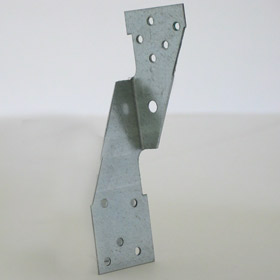
They are used in deck and roof construction. I believe the name comes from their use in deck construction, in that case they are holding the cross supports down and in place in the case of strong upward/lateral winds.

I have not actually put up my joists though and they are not the subject of this post. The real subject is a pedal powered generator.
 I realized last week that I am about to graduate from school, which means I am about to stop having access to the metal shop. I had thought about that before, but didn't think it was a big deal because I've been exclusively using hand tools in my back yard for the last few months. Then I remembered that I want to have a pedal powered generator for my house, and if I don't make it now, I will have to make it using hand tools in my back yard. That prospect was not appealing, so I put the house on hold and got to work.
I realized last week that I am about to graduate from school, which means I am about to stop having access to the metal shop. I had thought about that before, but didn't think it was a big deal because I've been exclusively using hand tools in my back yard for the last few months. Then I remembered that I want to have a pedal powered generator for my house, and if I don't make it now, I will have to make it using hand tools in my back yard. That prospect was not appealing, so I put the house on hold and got to work.A pedal power generator is a surprisingly simple thing. At least, to make it generate power. I have not yet hooked this thing up to charge a battery, which is what it will do eventually, and that I imagine is the more complicated part, I need to do more research because I am fuzzy on the details.
Anyway, a motor and a generator are the same thing. If you input electricity you have a motor, with a rotational output, and if you input the rotation you have a generator, with an electrical output. I am simplifying a lot, and possibly being a little bit liberal with my language, but if you have a motor and you hook it up to a voltmeter and turn the output shaft you will see that volts are happening.
For my generator I ordered an electric scooter motor off of ebay. It looks a lot like this:
 Then I spent a while trying to decide what variety of pedaling device I wanted. There are about half a million plans on the internet, each with their own advantages. I decided to go with what seems like the simplest. The simplest plan (in my mind) is having a bike trainer stand that holds up a regular bike, and the tire rests on the output shaft of the motor and turns it.
Then I spent a while trying to decide what variety of pedaling device I wanted. There are about half a million plans on the internet, each with their own advantages. I decided to go with what seems like the simplest. The simplest plan (in my mind) is having a bike trainer stand that holds up a regular bike, and the tire rests on the output shaft of the motor and turns it.The first step was building the bike stand:






The bike is held up by the nuts that hold the tire on. The pipe on the right is adjustable, the bike is put in place then the pipe is slid over and locked in, and the tire rests on the output shaft of the motor.
 I hooked the motor up to a multimeter and give it a test ride. I got up to about 80 volts. To be honest I'm not sure what that will mean in terms of charging the battery, but I'll update as I know. For now I think I have a good starting point for my generator.
I hooked the motor up to a multimeter and give it a test ride. I got up to about 80 volts. To be honest I'm not sure what that will mean in terms of charging the battery, but I'll update as I know. For now I think I have a good starting point for my generator.